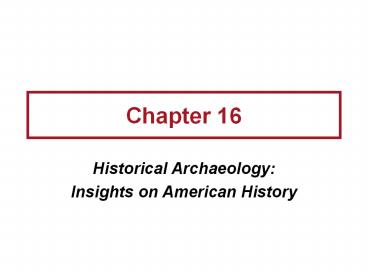Historical Archaeology: PowerPoint PPT Presentation
Title: Historical Archaeology:
1
Chapter 16
- Historical Archaeology
- Insights on American History
2
Outline
- Historical Archaeology Just a Handmaiden to
History? - Hidden History The Archaeology of
African-Americans - Correcting Inaccuracies
- Re-Examining Americas History
- Conclusion Historical Archaeologys Future
3
Historical Archaeology
- Looks at material remains from past societies
that also left behind written documentation about
themselves. - The first historical archaeology in America took
place about 150 years ago. - James Hall, a civil engineer, and direct
descendant of Miles Standish, located the
foundations of the Standish homestead in Duxbury,
Massachusetts and, in 1853, he conducted detailed
excavations there.
4
Historical Archaeology
- During the first half of the 20th century,
historical archaeologists labored mostly to
supplement historical records. - This perspective is evident in public
interpretive projects, such as Plymouth
Plantation, Colonial Williamsburg, and the Little
Bighorn battlefield. - Such projects concentrated on a very few selected
sites, particularly houses of the rich and
famous, forts, and military sites.
5
Historical Archaeology Comes of Age
- Mainstream historical archaeology began to look
at the larger social context, rather than at
historical significance. - In the 1960s, historical archaeology began to
focus on historically disenfranchised groups,
seeking to uncover the history of African-
Americans, Asian-Americans, Native Americans
during the historic period, and
Hispanic-Americans.
6
Characteristics of Historical Archaeology
- Modern historical archaeology often has a
strongly postprocessual flavor. - Deal with time periods that are considerably
shorter than those of prehistoric archaeology. - Historical archaeology is often very close to
ustemporally and emotionally.
7
Themes in Historical Archaeology
- The study of historically disenfranchised groups.
- Questions about the recent past that history
books answer unsatisfactorily. - The nature of European colonialism (the
developing capitalism of that time) and its
effects on indigenous peoples.
8
Map of Monticello
9
New York Citys African Burial Ground
- In 1991, the bones of 427 enslaved Africans,
interred by their community and forgotten for
centuries, were discovered beneath a parking lot
in downtown New York City. - In 1626, the Dutch West India Company unloaded
its first shipment of enslaved Africans in New
Amsterdam (todays New York City) 11 young men.
10
New York Citys African Burial Ground
- The Dutch were experiencing a labor shortage in
their colonies, and found slave labor to be the
answer to building and maintaining the colony. - 18th century New York law prohibited the burial
of Africans in Manhattans churchyards. - New Yorks African population established a
cemetery outside of the city and from 1712 to
1790, the community buried between 10,000 and
20,000 people.
11
New York Citys African Burial Ground
- Dr. Michael L. Blakeys analysis of some 400
individuals from the burial ground found that
half the population died before age 12. - Some were clearly worked to death
- Enlarged muscle attachments demonstrated
continual demands on their physical labor. - Bones showed cranial and spinal fractures from
excessive loads on the head and shoulders.
12
Fort Mose Colonial Americas Black Fortress of
Freedom
- Fort Mose, 50 miles south of the Georgia-Florida
border was the first legally sanctioned, free
African-American community in the country. - Beginning with the founding of Charles Towne by
the British in 1670, Spain employed free Africans
to further its colonial objectives by having them
populate and hold territories vulnerable to
foreign encroachment.
13
Fort Mose Colonial Americas Black Fortress of
Freedom
- Both free and slave Africans were used in
military operations, a black militia having been
established in St. Augustine. - By 1673, the Spanish crown declared that all
escaped fugitives from British plantations were
to be granted sanctuary and, eventually, freedom
in Spanish Florida so that by their example and
by my liberality, others will do the same.
14
Medieval Mind-set
- The culture of the early (pre-AD 1660) British
colonies that emphasized the group rather than
the individual and in which the line between
culture and nature was blurred people were seen
as conforming to nature.
15
Georgian Order
- A worldview (ca. 1660/16801820) arising in the
European Age of Reason and implying that the
world has a single, basic immutable order. - Using the powers of reason, people can discover
what that order is and control the environment as
they wish. - The Georgian order is informed by the rise of
scientific thought and by the order in
Renaissance architecture and art.
16
Future of Historical Archaeology
- Historical archaeology is today one of the most
rapidly expanding and exciting directions in
Americanist archaeology. - Challenges to existing histories and the recovery
of the history of disenfranchised groupswill
generate debates and dialog for years.
17
Quick Quiz
18
- 1. _____ _____ looks at material remains from
past societies that also left behind written
documentation about themselves.
19
Answer historical archaeology
- Historical archaeology looks at material remains
from past societies that also left behind written
documentation about themselves.
20
- 2. In the 1960s, historical archaeology began to
focus on - Elite colonial settlements.
- Diary entries of colonial women.
- Historically disenfranchised groups.
- All of the above.
21
Answer C
- In the 1960s, historical archaeology began to
focus on historically disenfranchised groups.
22
- 3. Fort Mose is important because it is
considered - The first legally sanctioned, free
African-American community in the country. - The burial site of hundreds of former slaves.
- The only former fort that preserved historic
documents such as diaries and civil records. - All of the above.
23
Answer A
- Fort Mose is important because it is considered
the first legally sanctioned, free
African-American community in the country.

